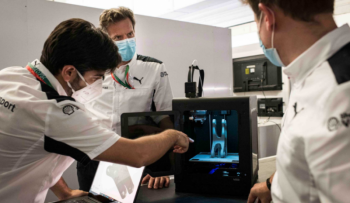
The BMW Group already applies 3D printing to production procedures in many areas – and BMW Motorrad Motorsport is also relying on this innovative technology with the BMW Motorrad WorldSBK Team. It enables fast and efficient production of new prototype components right at the circuit. These can then be tested on the BMW S 1000 RR before they go into final production in Munich or at supplier locations.
Munich. The BMW Group already applies 3D printing to production procedures in many areas – and BMW Motorrad Motorsport is also relying on this innovative technology with the BMW Motorrad WorldSBK Team. It enables fast and efficient production of new prototype components right at the circuit. These can then be tested on the BMW S 1000 RR before they go into final production in Munich or at supplier locations. It also means that smaller parts that are often not subject to intense stresses can be made on-site and then used in races.
Normally, the process is that engineers develop new components, which are simulated on computers, manufactured in metal or carbon, installed on the motorbike and then tested on the racetrack. However, the 3D printing capability makes it possible to develop and test new components during race operations. BMW Motorrad Motorsport has a portable 3D printer that travels to each circuit in the truck and is then assembled in the BMW Motorrad WorldSBK Team pit area on race weekends in the FIM Superbike World Championship (WorldSBK).
“This technology allows us to make improvements to the RR quickly and efficiently. The development of a WorldSBK bike is an ongoing process and it is often the minor details that make a motorbike better,” said BMW Motorrad Motorsport Director Marc Bongers. “Behind the scenes, our engineers are always working on adjusting and optimising individual bike components, all within the framework of changes permitted by the regulations. We can use 3D printing to implement these at the racetrack, even during race events. We then take the acquired data and the subsequent analyses – combined with comments from the drivers or input from the mechanics working on the bike itself – and generate input for the development team. This input contributes to the emergence of ideas that can be implemented directly in existing constructions or in simulations and iterative processes that lead to new constructions, all of which are executed in CAD. The new components are printed as plastic variants and their functions and ease of installation are checked on the bike. This process is now much faster than when we had to wait until the parts were produced either internally or externally and made available for evaluation at the racetrack. It is also easier to evaluate potential touching with surrounding parts or restricted access than it would be on screen.”


